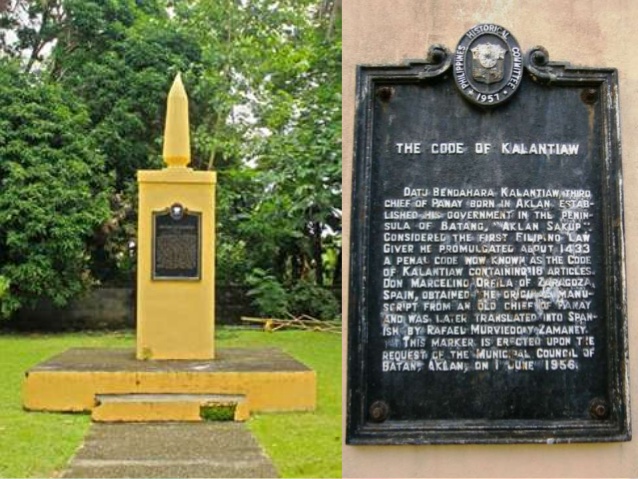
Kalantiaw Shrine
In the pre-Spanish days of Panay Island, there was a datu who ruled Aklan, one of the three kingdoms in the island. His name was Datu Bendahara Kalantiaw, a descendant of the ten datus of Borneo. In 1433, he issued what was known as the Kalantiaw Code, a set of 18 laws that governed his kingdom and his subjects.
But the Code of Kalantiaw was debunked and proved to be just a hoax. William Henry Scott, a historian who focused on the Cordilleras and the Pre-Spanish Philippines, successfully defended as part of his doctoral dissertation his findings that the code was a fraud that a certain Jose E. Marco perpetuated. Don Marcelino Orfila of Zaragoza, Spain obtained the original manuscript of the Code from an old chief of Panay and was later translated into Spanish by Rafael Murviedo y Zamaney.
On June 1, 1956, acting upon the request of the Municipal Council of Batan, the Philippine Historical Committee installed a marker in a tract of land near the bay.On February 11, 1957, President Ramon Magsaysay approved Executive Order No. 234 declaring the site as a national shrine. Then January 24, 1973, President Ferdinand E. Marcos signed Presidential Decree No. 105 declaring national shrines such as as sacred (hallowed) places and prohibiting desecration thereof.
But the Code of Kalantiaw was debunked and proved to be just a hoax. William Henry Scott, a historian who focused on the Cordilleras and the Pre-Spanish Philippines, successfully defended as part of his doctoral dissertation his findings that the code was a fraud that a certain Jose E. Marco perpetuated. Don Marcelino Orfila of Zaragoza, Spain obtained the original manuscript of the Code from an old chief of Panay and was later translated into Spanish by Rafael Murviedo y Zamaney.
On June 1, 1956, acting upon the request of the Municipal Council of Batan, the Philippine Historical Committee installed a marker in a tract of land near the bay.On February 11, 1957, President Ramon Magsaysay approved Executive Order No. 234 declaring the site as a national shrine. Then January 24, 1973, President Ferdinand E. Marcos signed Presidential Decree No. 105 declaring national shrines such as as sacred (hallowed) places and prohibiting desecration thereof.
photo: Tiffany Ashley Cayetano
description: LEGENDHARRY